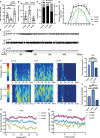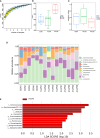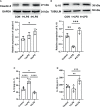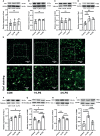Intestinal Flora Composition Determines Microglia Activation and Improves Epileptic Episode Progress
- PMID: 35356535
- PMCID: PMC8959590
- DOI: 10.3389/fcimb.2022.835217
Intestinal Flora Composition Determines Microglia Activation and Improves Epileptic Episode Progress
Abstract
In response to environmental stimuli, immune memory mediates the plasticity of myeloid cells. Immune training and immune tolerance are two aspects of plasticity. Microglia that are immunologically trained or immunologically tolerant are endowed with a tendency to differentiate into alternative dominant phenotypes (M1/M2). Male C57BL/6 mice (immune-training group, immune-tolerant group, and control group) were used to establish the kainic acid epilepsy model. The seizure grade, duration, latency, hippocampal potential, and energy density were used to evaluate seizures, and the changes in the polarization of microglia were detected by western blot. 16S rDNA sequencing showed that the abundance of Ruminococcus in the immune-tolerant group was the dominant flora. Our research connections Intestinal microorganisms, brain immune status, and epilepsy behavior together. Pro-inflammatory M1 phenotype and anti-inflammatory M2 phenotype mediate and enhance and suppress subsequent inflammation, respectively. We conclude that intestinal microorganisms influence the occurrence and development of epilepsy by regulating the polarization of microglia.
Keywords: 16S rDNA; epilepsy; gut-brain axis; immune tolerance; intestinal flora; microglia.
Copyright © 2022 Ding, Zhou, Zhao, Chen, Wang, Zhang, Zhang and Jiang.
Conflict of interest statement
The authors declare that the research was conducted in the absence of any commercial or financial relationships that could be construed as a potential conflict of interest.
Figures






Similar articles
-
Intracerebral delivery of the M2 polarizing cytokine interleukin 13 using mesenchymal stem cell implants in a model of temporal lobe epilepsy in mice.Epilepsia. 2017 Jun;58(6):1063-1072. doi: 10.1111/epi.13743. Epub 2017 Apr 4. Epilepsia. 2017. PMID: 28374921
-
Tea polyphenols ameliorates memory decline in aging model rats by inhibiting brain TLR4/NF-κB inflammatory signaling pathway caused by intestinal flora dysbiosis.Exp Gerontol. 2021 Oct 1;153:111476. doi: 10.1016/j.exger.2021.111476. Epub 2021 Jul 12. Exp Gerontol. 2021. PMID: 34265410
-
Regulation of Microglia and Macrophage Polarization via Apoptosis Signal-Regulating Kinase 1 Silencing after Ischemic/Hypoxic Injury.Front Mol Neurosci. 2017 Aug 14;10:261. doi: 10.3389/fnmol.2017.00261. eCollection 2017. Front Mol Neurosci. 2017. PMID: 28855861 Free PMC article.
-
Butylphthalide has an Anti-Inflammatory Role in Spinal Cord Injury by Promoting Macrophage/Microglia M2 Polarization via p38 Phosphorylation.Spine (Phila Pa 1976). 2020 Sep 1;45(17):E1066-E1076. doi: 10.1097/BRS.0000000000003503. Spine (Phila Pa 1976). 2020. PMID: 32205688
-
Maturation, Morphology, and Function: The Decisive Role of Intestinal Flora on Microglia: A Review.J Integr Neurosci. 2023 May 9;22(3):70. doi: 10.31083/j.jin2203070. J Integr Neurosci. 2023. PMID: 37258438 Review.
Cited by
-
A review of the pathogenesis of epilepsy based on the microbiota-gut-brain-axis theory.Front Mol Neurosci. 2024 Oct 3;17:1454780. doi: 10.3389/fnmol.2024.1454780. eCollection 2024. Front Mol Neurosci. 2024. PMID: 39421261 Free PMC article. Review.
-
The interplay between microbiota and brain-gut axis in epilepsy treatment.Front Pharmacol. 2024 Jan 26;15:1276551. doi: 10.3389/fphar.2024.1276551. eCollection 2024. Front Pharmacol. 2024. PMID: 38344171 Free PMC article. Review.
-
Microglia in Microbiota-Gut-Brain Axis: A Hub in Epilepsy.Mol Neurobiol. 2024 Sep;61(9):7109-7126. doi: 10.1007/s12035-024-04022-w. Epub 2024 Feb 17. Mol Neurobiol. 2024. PMID: 38366306 Review.
-
Broadening horizons: microbiota as a novel biomarker and potential treatment for endometriosis.Front Microbiol. 2025 Apr 17;16:1521216. doi: 10.3389/fmicb.2025.1521216. eCollection 2025. Front Microbiol. 2025. PMID: 40313408 Free PMC article. Review.
-
The Influence of the Probiotics, Ketogenic Diets, and Gut Microbiota on Epilepsy and Epileptic Models: A Comprehensive Review.Mol Neurobiol. 2025 May 2. doi: 10.1007/s12035-025-04993-4. Online ahead of print. Mol Neurobiol. 2025. PMID: 40316878 Review.

